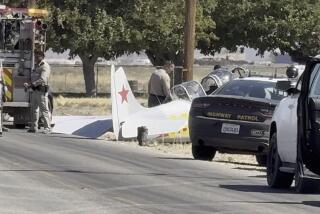2 Air Tanker Crashes Are Blamed on Fatigue Cracks
- Share via
Fatigue cracks caused the wings to snap off two aging planes as they dropped fire retardant on blazes in the High Sierra and the Rocky Mountains in recent months, federal safety officials said Monday.
The June 17 crash of a 45-year-old C-130A near Walker, Calif., captured on a videotape that showed both wings breaking off, killed the three crewmen aboard. The crash a month later of a 58-year-old PB4Y-2 near Estes Park, Colo., killed the pilot and co-pilot.
The National Transportation Safety Board said the crashes have raised important questions about old surplus military aircraft now being flown as air tankers and for other public uses. All C-130s and PB4Ys in the firefighting fleet were grounded after the crashes, but more than 30 other large vintage planes are still being used to fight fires.
The discovery of the wing cracks is prompting the NTSB to restudy some earlier air tanker accidents, including the 1994 crash of another C-130 near Pearblossom. That accident was blamed initially on a fuel explosion, but investigators now say fatigue cracks may have caused the crash.
Since the crashes in June and July, much smaller wing cracks have been found on several other planes being used as air tankers, and the U.S. Forest Service has reduced the loads being carried on the tankers still flying.
Investigators said the fatigue cracks on the planes that crashed were confined to the wing structures. Yet to be determined, they said, is what initiated the cracks and what caused them to spread until the wings broke off under the stress of dropping heavy loads of liquid fire retardant.
The NTSB said the cracks were in places not easily accessible for inspection during the periodic maintenance required by the Federal Aviation Administration. The FAA is expected to issue a directive later this week addressing the inspection and maintenance of the aircraft.
Both planes were owned by Hawkins and Powers, a firm based in Greybull, Wyo., that converts former cargo and military aircraft for use as air tankers and operates the planes under contracts with the Forest Service. The NTSB said it is taking a close look at the modification and maintenance history of both planes.
The C-130 was designed for use as a military cargo plane, and the PB4Y was built as a Navy patrol plane. The NTSB is questioning whether those designs are appropriate for dive-bombing tankers in the war against wildfires.
The four-engine, turboprop C-130 Hercules that crashed had taken off about 2:30 p.m. June 17 from Minden, Nev., for a seemingly routine series of fire retardant drops on a 10,000-acre wildfire about 25 miles north of Yosemite National Park.
Videotape shot by a witness, and later broadcast nationwide, shows the plane was in a shallow dive, dropping retardant, when the wings suddenly snapped upward, less than half a second apart. The plane slammed into the ground near Walker and burst into flames.
Killed were pilot Steven Wass, 42, of Gardnerville, Nev.; co-pilot Craig Labare, 36, of Loomis, Ca., and flight engineer Michael Davis, 59, of Bakersfield.
The C-130 that crashed was built by Lockheed in 1957 and delivered to the Air Force later that year. It went into use as an air tanker in 1988. At the time of the crash, the plane had 21,863 flight hours.
The four-engine, World-War-II vintage PB4Y that crashed July 18 was in a banking left turn, preparatory to making a retardant drop on a 4,100-acre wildfire near Estes Park, Colo., when the left wing broke off.
The fuselage slammed into the ground, killing pilot Rick Schwartz, 39, of Ulm, Mont., and co-pilot Milt Stollak, 56, of Cathedral City.
Built by Consolidated-Vultee in 1944, the plane was used by the Navy and Coast Guard before it was acquired by Hawkins and Powers in 1969. Its flight time as an air tanker was 8,200 hours, but officials have been unable to determine how many hours it flew in military service.
More to Read
Sign up for Essential California
The most important California stories and recommendations in your inbox every morning.
You may occasionally receive promotional content from the Los Angeles Times.













